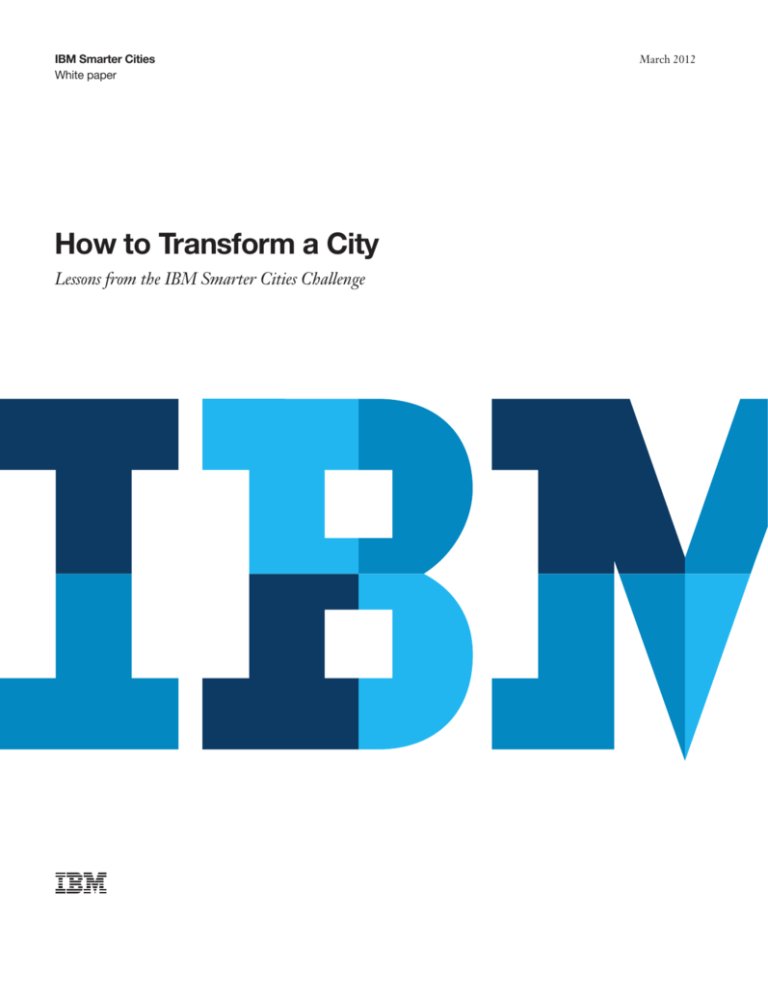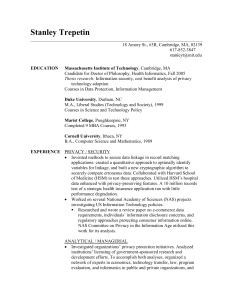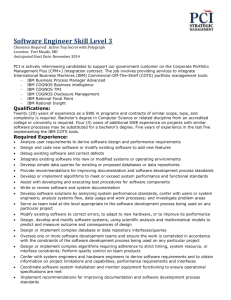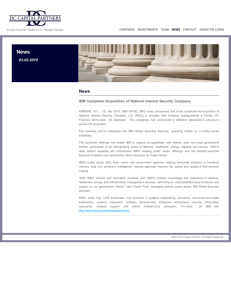
IBM Smarter Cities
White paper
How to Transform a City
Lessons from the IBM Smarter Cities Challenge
March 2012
2
How to Transform a City
Smarter Cities
Challenge
100 cities
3 years
$50 million
It’s no easy feat to transform the way a city works, but, with the
global urban population swelling at a rapid pace, city leaders
are under intense pressure to deliver services more efficiently,
solve difficult social problems and promote economic vitality.
IBM’s Smarter Cities Challenge grant program, a three-year,
100-city initiative where IBM is donating $50 million worth of
its employees’ time, is aimed at helping cities get started on
ambitious projects. IBM dispatches five- or six-person teams of
experts in a range of disciplines to help cities formulate
strategies for improving the quality of life for their citizens.
The cities are chosen based on having a critical issue to resolve
and a strong commitment from the mayor or city manager to
acting on recommendations. The leaders must be willing to share
information and open doors in their community for IBM, and to
engage with citizens, other elected officials, non-profits,
businesses and government agencies so their communities can
make more informed and collaborative decisions. At the end of
each engagement, the team hands over a detailed report sizing up
the issue and making recommendations for getting things done.
IBM has amassed a wealth of knowledge about how to help
cities get started on transformational projects. Last year, the
company engaged with 25 cities around the world, including
St. Louis in the United States, Glasgow in the United
Kingdom, Chiang Mai in Thailand and Johannesburg in South
Africa. The previous year, IBM ran test programs in Ho Chi
Minh City, Vietnam; Katowice, Poland; Rio de Janeiro, Brazil;
Chengdu, China; and elsewhere. The themes of the projects
ranged from education, transportation and public safety, to
energy and sustainable economic development.
“The secret of getting ahead is getting started.”
— Mark Twain
After each engagement, IBM’s Corporate Citizenship team
identifies lessons learned. The exercise is partly aimed at
improving the program itself, but the team also gleans insights
that could help any leader in any city launch an initiative aimed
at fundamentally transforming an aspect of how the city works.
Here are some of the most critical lessons for leaders:
Be Bold — Even Audacious
If you don’t set a high bar and really challenge yourselves, the
progress you make will be marginal at best.
The United Kingdom, for instance, has set a target of halving
carbon emissions from 1990 levels by 2025 — with a progress
report due in 2014. Glasgow, a Scottish industrial city, will
require significant improvements in energy conservation to
meet the overall goals. But, at the same time, the city has a
high ratio of poor people who suffer from what city leaders call
“fuel poverty.” Nearly 35% of Glasgow households can’t afford
to heat their homes properly. The goal is to address both
problems with the same initiative. For starters, the city is
paying for a fuel subsidy program for poor people using the
proceeds from clean energy projects.
IBM Smarter Cities
3
Pick a Target That’s a Shared Priority
Lessons for Leaders
- Be bold, even audacious
- Break down bureaucratic barriers
- Partner with the private sector
- Encourage citizen involvement
- Understand the value of data
- Embrace transparency
- Prepare to be surprised
- Invest for the future
- Take action immediately
Think Differently
Be willing to try new ways of doing things. Just being more
efficient with conventional approaches, even those that worked
well in the past, won’t work best now.
Antofagasta, Chile, is a thriving port city in the country’s arid
mining region, but it lacks some of the quality-of-life amenities
befitting a city of its size and importance. The city leaders
decided to take an unusual tactic: Make the city greener,
literally, by irrigating parks and open spaces. Yet the dry
climate made that goal particularly challenging. The IBM team
crafted a set of proposals designed to get the most out of the
limited supply of water.
To get something difficult done, it will have to be at or near the
top of the priority lists of all of the participants. Everybody
involved has to pull together or the group will be pulled apart.
The political leaders in Mecklenburg County, North Carolina,
and Charlotte, the county seat, invited municipal leaders from
throughout the county to come together and agree on a project
they could take on together. The theme they settled on,
integrated regional capital planning, may not seem sexy, but, in
a state where local government power is dispersed, it’s a
necessary step for getting big things done.
Address Challenges Holistically
There’s rarely a silver bullet that solves a complex problem. It’s
important to view a particular issue in its totality, and come up
with a coordinated set of solutions.
Farmers in Chiang Mai, Thailand, the principal city in an
agricultural region, face a host of challenges, including water
shortages, occasional flooding, overproduction, price pressures
and stagnant demand for products. The IBM team proposed a
plan designed to address weather, irrigation, the coordination
of production, food traceability, branding of Chiang Mai’s
crops and expansion to global markets.
Create the Right Balance
of Ambition and Focus
There’s an art to choosing a goal that is both ambitious and
manageable. Cities are complex systems of systems and must
be viewed in their totality, but leaders have to pick a place to
begin. The second part of the Mark Twain quote is: “The
secret of getting started is breaking your complex,
overwhelming tasks into small manageable tasks, and then
starting on the first one.”
In retrospect, several cities initially proposed initiatives that
were too broad to be grappled with in a few weeks. Austin,
Texas, initially wanted to use technology to bridge the divide
between economically and racially diverse sections of the city.
The IBM team decided to focus on specific improvements to
the delivery of social services as a first step.
4
How to Transform a City
Break Down Bureaucratic Barriers
City departments and regional government agencies often
operate in near isolation from one another, but that’s a major
barrier to getting things done. Mayors must find ways to
compel or convince agency heads to collaborate and share data.
In St. Louis, which has a reputation as one of the most
dangerous cities in the United States, city leaders came to the
table ready for new ideas about how to reduce crime. The
mayor led the initiative even though several of the
organizations involved, including police and the corrections
department, aren’t under his control. The group accepted the
IBM team’s recommendation that they create a new public
safety system where they will coordinate processes and share
data across organizational borders.
Partner with Businesses and Non-profits
It’s important for city governments to engage with other actors
in society, including universities and other non-profits, business
organizations and individual businesses. Also, the earlier you
get all the stakeholders involved, the better.
In Philadelphia, the Digital On-Ramps Initiative is aimed at
preparing residents to work and thrive in the 21st century
economy. The initiative is being planned and managed by a
consortium of institutions, including city departments,
Drexel University, and a handful of civic groups, including
the Greater Philadelphia Urban Affairs Coalition, which is
made up of representatives from government, business and
neighborhood groups.
Encourage Citizen Involvement
Citizens can provide valuable insights into the most effective
ways to improve the quality of life in their city. In this social
networking era, it’s even more crucial to engage with citizens,
and, thanks to all of the new technology tools that are available,
it’s easier to do so.
Helsinki, Finland, faces social shifts resulting from an
aging native population combined with immigration from
Eastern European countries. It aims to open its data to the
public, but needs to identify the most effective ways for
communicating with a changing citizenry. The IBM team met
with a group of citizens gathered at a local university and
solicited ideas for open-data applications that would appeal to
the people of Helsinki.
Understand the Value of Data
Evidence-based decision making really works. You can
do things smarter and better, also more efficiently and
more quickly.
In Syracuse, New York, a former industrial center with a
sizable housing vacancy problem, city leaders realized that
gathering and analyzing data is crucial to identifying which
troubled neighborhoods have the highest potential for
turnarounds. That way they could focus resources on them. A
close look at the data showed — perhaps counter-intuitively —
that neighborhoods with a high rate of calls to the police about
drug use and loud disturbances have a high potential for being
saved. It means the residents care enough to complain.
Embrace Transparency
Open up city data and combine it with data from other sources.
It’s not enough just to put data online. You have to present it in
ways that makes it easy for citizens to use.
In Providence, city managers are improving the process for
getting real estate development projects off the ground by
pulling data from more than a half-dozen departments that
have roles in issuing permits. They’re creating a single,
end-to-end online application process aimed at dramatically
reducing the time it takes to get a final go-ahead to begin
construction or renovation.
Prepare to be Surprised
Many cities were formed decades or centuries ago as
manufacturing or transportation hubs. In some cases, their
original reasons for being are gone. Today, the most successful
cities are magnets for well educated and creative people whose
ideas improve through interactions with one another. Out of
that social blender come some startling ideas.
IBM Smarter Cities
Who could have guessed that aquaponics (food production
systems that combine fish-raising with cultivating plants in
water) would become a big deal in Milwaukee, and attract avid
interest from other cities? It did. The city is piloting a program
where the waste from fish-raising tanks is used to grow
vegetables — which are served in city restaurants.
Don’t Reinvent the Wheel
While there are plenty of differences between cities, they also
have a lot in common--whether they’re big or small, mature or
fast-growing, in North America or Southeast Asia. Through
IBM’s network, city leaders can be put in touch with their
counterparts in cities who have come up with solutions to
similar problems.
When leaders in Providence set out to come up with a plan for
redeveloping a swath of the city’s downtown that had formerly
been a highway, they consulted with city managers in
Baltimore and Mecklenburg County, North Carolina, about
ways to make the land-use permitting process more efficient.
Set Up a Performance
Management System
The adage, “If you can’t measure it you can’t manage it,” is
attributed to 20th century business management guru Peter
Drucker. That goes for government leaders, as well.
New Orleans, Louisiana, launched a performance management
tool called BlightSTAT in 2010 to implement they mayor’s
Blight Strategy, which aims to reduce the number of blighted
properties by 10,000 by 2014. The city gathers data and hosts
open meetings with community leaders and government
officials to craft strategies for improving the system. The IBM
team provided guidance on how to improve the BlightSTAT
technology and how to roll out STAT programs for other
initiatives.
5
Invest for the Future
Sure, money is tight, but cities must be prepared to invest up
front for long term benefits.
Chengdu, China, has laid out a five-year plan for investing
in cloud computing resources to support its many Intelligent
Chengdu initiatives. Chicago, Illinois, plans to invest in
creating five new science and technology-focused schools,
which combine high school and community college, in
partnerships with IBM and four other corporations. The
city’s leaders understand that they have to invest in programs
that will take years to deliver results. They think it’s vital to
creating the skilled workforce that’s necessary to sustain a
dynamic economy.
Take Action Immediately
The research and final report aren’t of much value if cities
don’t take action based on them. These can be small steps:
reallocation of funds, new data gathered, a working group set
up or a staff position created. The most important thing is to
keep the process moving.
A number of the cities were quick to implement some of IBM’s
recommendations. For instance, Mecklenberg County, North
Carolina, has signed agreements with all its municipalities to
develop a consolidated capital budget planning process.
Philadelphia, Pennsylvania, is developing a program for
helping residents to continue or resume their educations. And
Edmonton, Alberta, Canada, analyzes traffic data more
rigorously to improve road safety.
© Copyright IBM Corporation 2012
IBM Corporate
1 New Orchard Road
Armonk, NY 10504
U.S.A.
Produced in the United States of America
March 2012
All Rights Reserved
IBM, the IBM logo and ibm.com are trademarks or registered trademarks
of International Business Machines Corporation in the United States, other
countries, or both. If these and other IBM trademarked terms are marked
on their first occurrence in this information with a trademark symbol
(® or ™), these symbols indicate U.S. registered or common law
trademarks owned by IBM at the time this information was published.
Such trademarks may also be registered or common law trademarks in
other countries. A current list of IBM trademarks is available on the Web
at “Copyright and trademark information” at ibm.com/legal/copytrade.
shtml Other company, product and service names may be trademarks or
service marks of others.
References in this publication to IBM products and services do not
imply that IBM intends to make them available in all countries in which
IBM operates.
Please Recycle
BCE-01565-USEN-00








